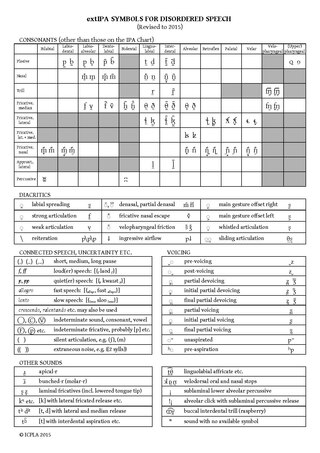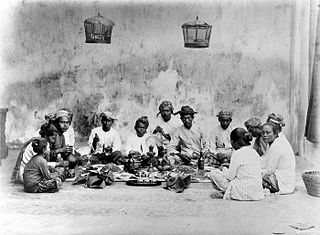
In spoken language analysis, an utterance is a continuous piece of speech, by one person, before or after which there is silence on the part of the person. In the case of oral languages, it is generally, but not always, bounded by silence. Utterances do not exist in written language; only their representations do. They can be represented and delineated in written language in many ways.
Glossophobia or speech anxiety is the fear of public speaking. The word glossophobia derives from the Greek γλῶσσα glossa (tongue) and φόβος phobos The causes of glossophobia are uncertain but explanations include communibiology and the illusion of transparency. Further explanations range from nervousness produced by a lack of preparation to, one of the most common psychiatric disorders, social anxiety disorder (SAD).
An interjection is a word or expression that occurs as an utterance on its own and expresses a spontaneous feeling or reaction. It is a diverse category, encompassing many different parts of speech, such as exclamations (ouch!, wow!), curses (damn!), greetings, response particles, hesitation markers, and other words. Due to its diverse nature, the category of interjections partly overlaps with a few other categories like profanities, discourse markers, and fillers. The use and linguistic discussion of interjections can be traced historically through the Greek and Latin Modistae over many centuries.
In the broadest sense of the word, a vocable is any meaningful sound uttered by people, such as a word or term, that is fixed by their language and culture. Use of the words in the broad sense is archaic and the term is instead used for utterances which are not considered words, such as the English vocables of assent and denial, uh-huh and uh-uh, or the vocable of error, uh-oh.
A speech disfluency, also spelled speech dysfluency, is any of various breaks, irregularities, or non-lexical vocables which occur within the flow of otherwise fluent speech. These include "false starts", i.e. words and sentences that are cut off mid-utterance; phrases that are restarted or repeated, and repeated syllables; "fillers", i.e. grunts, and non-lexical or semiarticulate utterances such as huh, uh, erm, um, and hmm, and, in English, well, so, I mean, and like; and "repaired" utterances, i.e. instances of speakers correcting their own slips of the tongue or mispronunciations. Huh is claimed to be a universal syllable.
In linguistics, prosody is the study of elements of speech that are not individual phonetic segments but which are properties of syllables and larger units of speech, including linguistic functions such as intonation, stress, and rhythm. Such elements are known as suprasegmentals.

The Mk 2 grenade, also nicknamed the Pineapple is a fragmentation-type anti-personnel hand grenade introduced by the U.S. armed forces in 1918. It was the standard issue anti-personnel grenade used during World War II, and also saw limited service in later conflicts, including the Korean War and Vietnam War. Replacing the failed Mk 1 grenade of 1917, it was standardized in 1920 as the Mk II, and redesignated the Mk 2 on April 2, 1945.
Formulaic language is a linguistic term for verbal expressions that are fixed in form, often non-literal in meaning with attitudinal nuances, and closely related to communicative-pragmatic context. Along with idioms, expletives and proverbs, formulaic language includes pause fillers and conversational speech formulas.

The Extensions to the International Phonetic Alphabet for Disordered Speech, commonly abbreviated extIPA, are a set of letters and diacritics devised by the International Clinical Phonetics and Linguistics Association to augment the International Phonetic Alphabet for the phonetic transcription of disordered speech. Some of the symbols are used for transcribing features of normal speech in IPA transcription, and are accepted as such by the International Phonetic Association.
A speech error, commonly referred to as a slip of the tongue or misspeaking, is a deviation from the apparently intended form of an utterance. They can be subdivided into spontaneously and inadvertently produced speech errors and intentionally produced word-plays or puns. Another distinction can be drawn between production and comprehension errors. Errors in speech production and perception are also called performance errors. Some examples of speech error include sound exchange or sound anticipation errors. In sound exchange errors, the order of two individual morphemes is reversed, while in sound anticipation errors a sound from a later syllable replaces one from an earlier syllable. Slips of the tongue are a normal and common occurrence. One study shows that most people can make up to as much as 22 slips of the tongue per day.
Filler is material of lower cost or quality that is used to fill a certain television time slot or physical medium, such as a music album.
In linguistics, a filler, filled pause, hesitation marker or planner is a sound or word that participants in a conversation use to signal that they are pausing to think but are not finished speaking. These are not to be confused with placeholder names, such as thingamajig. Fillers fall into the category of formulaic language, and different languages have different characteristic filler sounds. The term filler also has a separate use in the syntactic description of wh-movement constructions.

The slametan is the communal feast from Java, symbolizing the social unity of those participating in it. Clifford Geertz considered it the core ritual in Javanese religion, in particular the abangan variant. The feast is common among the closely related Javanese, Sundanese and Madurese people.

Filler materials are particles added to resin or binders that can improve specific properties, make the product cheaper, or a mixture of both. The two largest segments for filler material use is elastomers and plastics. Worldwide, more than 53 million tons of fillers are used every year in application areas such as paper, plastics, rubber, paints, coatings, adhesives, and sealants. As such, fillers, produced by more than 700 companies, rank among the world's major raw materials and are contained in a variety of goods for daily consumer needs. The top filler materials used are ground calcium carbonate (GCC), precipitated calcium carbonate (PCC), kaolin, talc, and carbon black. Filler materials can affect the tensile strength, toughness, heat resistance, color, clarity, etc. A good example of this is the addition of talc to polypropylene. Most of the filler materials used in plastics are mineral or glass based filler materials. Particulates and fibers are the main subgroups of filler materials. Particulates are small particles of filler that are mixed in the matrix where size and aspect ratio are important. Fibers are small circular strands that can be very long and have very high aspect ratios.
In linguistics, a prosodic unit is a segment of speech that occurs with specific prosodic properties. These properties can be those of stress, intonation, or tonal patterns.
Fluency refers to continuity, smoothness, rate, and effort in speech production. It is also used to characterize language production, language ability or language proficiency.
Fillers are used for packaging, mainly for food/beverage but for other products as well. These are used to fill either a bottle or a pouch, depending on the product.
Scanning speech is a type of ataxic dysarthria in which spoken words are broken up into separate syllables, often separated by a noticeable pause, and spoken with varying force. The sentence "Walking is good exercise", for example, might be pronounced as "Walk (pause) ing is good ex (pause) er (pause) cise". Additionally, stress may be placed on unusual syllables.
Injectable filler is a soft tissue filler injected into the skin at different depths to help fill in facial wrinkles, provide facial volume, and augment facial features: restoring a smoother appearance. Most of these wrinkle fillers are temporary because they are eventually absorbed by the body. Most dermal fillers today consist of hyaluronic acid, a naturally occurring polysaccharide that is present in skin and cartilage. Some people may need more than one injection to achieve the wrinkle-smoothing effect. The effect lasts for about six months or longer. Successful results depend on health of the skin, skill of the health care provider, and type of filler used. Regardless of material filler duration is highly dependent on amount of activity in the region where it is injected. Exercise and high intensity activities such as manual labor can stimulate blood flow and shorten the lifespan of fillers.

English interjections are a category of English words – such as yeah, ouch, Jesus, oh, mercy, yuck, etc. – whose defining features are the infrequency with which they combine with other words to form phrases, their loose connection to other elements in clauses, and their tendency to express emotive meaning. These features separate English interjections from the language's other lexical categories, such as nouns and verbs. Though English interjections, like interjections in general, are often overlooked in descriptions of the language, English grammars do offer minimal descriptions of the category.





